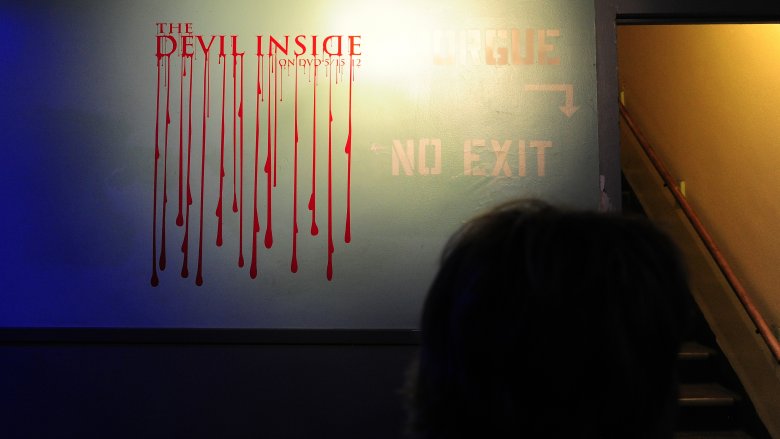The Untold Truth Of Movie Dump Months
For nearly four months out of the year, going to the movie theater is a grim endeavor. At the beginning of the year and during the waning days of summer, studios scrape the bottoms of their respective barrels and release their most lackluster films to poor moviegoers hungry for something—anything—to satiate their cinematic cravings. These are known as the dreaded "dump months," in which we're gifted with the likes of The Bye Bye Man and Underworld: Blood Wars when we really want Wonder Woman and Star Wars: The Last Jedi.
So why do studios always fob off their worst movies during these months? Why aren't blockbuster releases spaced out more evenly? Does it really have to be this way? Here's everything you need to know about movie dump months.
January wasn't always a dump month
January wasn't always a dumping ground for write-off films like Snow Dogs and Kangaroo Jack. In fact, in the first half of the 20th century, January was still very much a prime period for major studios to release their good stuff.
As noted by The New York Times, a lot of great films debuted in January, including "silent-era Charlie Chaplin hits like The Kid (1921) and The Circus (1928), the Garbo/John Gilbert melodrama Flesh and the Devil (1927) and Josef von Sternberg's Last Command (1928)." The trend was continued decades later with the release of top-notch stuff such as Preston Sturges's Sullivan's Travels (1942), Alfred Hitchcock's Shadow of a Doubt (1943) and John Huston's Treasure of the Sierra Madre (1948). In fact, John Ford's Grapes of Wrath, Howard Hawks's His Girl Friday, and Ernst Lubitsch's Shop Around the Corner all debuted in January 1940—an unbelievable release strategy by today's dump-month standards.
So what happened?
It all started with the Supreme Court
The modern movie release schedule and its infamous dump months stems from one decision by the U.S Supreme Court.
Known as "The Hollywood Antitrust Case of 1948" or "The Paramount Case," the high-profile United States v. Paramount Pictures, Inc. effectively put an end to the old studio system by holding that it was a violation of antitrust law for the studios to own theater chains. Previously, movie studios needn't worry so much about the financial success of their movies, because they could run them in their own monopolized theaters for as long as they wanted. The SCOTUS put an end to that, forcing studios to actually pay attention to important external factors which could bury their movies six feet under—thus officially conceiving dump months. Of course, there are a number of reasons they've continued to persist over the ensuing decades.
Heading back to school isn't cheap
Every time a school bell rings, a new movie loses its wings.
It's no coincidence that the two primary dump months for new movies—September and January—happen to be when children and college kids everywhere go back to school. While young to middle-aged adults make up the lion's share of frequent moviegoers, 15 percent of all regular audience members are between the ages of 12 and 17. Combined with the percentages of those under 11 (7 percent) and the college-aged demographic of those between 18 and 24 (19 percent), the total percentage of regular moviegoers potentially kept out of the theater by back-to-school book-learning is a whopping 41 percent. That's a lot of ticket buyers with their butts at desks instead of in theater chairs.
Heading back to school isn't exactly cheap, either. According to the 2017 Huntington Bank Backpack Index, parents spent roughly $662 per child to prep them for the first day of elementary school. The costs skyrocket for middle school and for high school students, sitting at $1,001 and $1,489 respectively. (And don't forget about all those college kids taking out substantial student loans!) While parents might make a day of it and hit up the movie theater while back-to-school shopping, it's safe to assume movie tickets are less of a priority after dropping some serious cash on school supplies.
Balancing the checkbook
Back-to-school spending isn't the only thing keeping moviegoers out of the theaters during dump months. Balancing the checkbook after vacations and holiday spending also rewards those who resist the urge to buy movie tickets.
Americans dropped more than $100 billion on summer vacations in 2017, with the average family spending $1,978 to get away. Millennials between the ages of 18-34 averaged a summer vacation expenditure of $1,373, with middle-aged adults under 54 spending $2,628. While increased consumer confidence and vacation spending is great news for the travel industry, it generally spells disaster for movie studios—who are left feeling the effects of families' belt-tightening after time off from work and all those travel costs.
Likewise, moviegoers are less likely to go to the movies after racking up a credit card bill on holiday shopping. According to a Gallup poll in November 2017, 34 percent of U.S. adults expected to spend $1,000 or more on Christmas gifts, with 22 percent expecting to spend between $500 and $999. Add in the additional bargain hunting that takes place during January sales, and it's easy to see why moviegoing gets axed from the post-holiday budget.
'Tis the season to play catch up
Even for those who still have the extra cash to see movies in January and February, that time is usually spent playing catchup on the previous year's best releases.
Traditionally, massive blockbusters such as Star Wars: The Last Jedi hit theaters in December, but hang around well into January and February—allowing fans to catch the film twice, thrice... or eight times. Additionally, Oscar-hungry films often see a limited release in December before expanding nationwide the following month as they're propelled by awards-show hype. Consequently, any good movie that isn't ready to go earlier than January opts to steer clear of the previous year's high-profile competition and awards season darlings.
Snowed in
If recovering from a holiday spending spree and catching up on the previous year's Oscar nominations aren't enough to keep moviegoers out of theaters in January and February, the weather is.
Let's face it—for a large portion of the United States and other countries, January and February are cold. Piling in the car to drive to the local cinema doesn't sound quite as appealing when you have to bundle up in layers, shovel the driveway, scrape an inch of ice off your car windows, and warm up the engine for ten minutes. If the weather outside is frightful, and the fire is so delightful... why bother leaving? It's much easier to stay home, whip up some hot chocolate, and binge-watch Orange Is the New Black.
Even if you are up for some winter driving, Mother Nature might make the decision for you. Winter storms can make it incredibly difficult to make it to the movie theater—which might not even be open. Is it really risk braving dangerous road conditions to check out a new film dumped at the mall? Probably not... and studios don't really expect you to.
Super Bowl Sunday
While holiday weekends usually provide moviegoers with an opportunity to check out the latest flicks, movies that run during the winter dump months—when we get Martin Luther King Jr. Day and Presidents' Day—don't exactly pack the theater. Making matters worse for studios, they also have to compete with the United States' largest unofficial holiday: Super Bowl Sunday.
Usually played on the last Sunday in January or the first Sunday in February, the National Football League's championship showdown sacks any thought of going to the cinema—more than 111 million viewers tune in to the game. Making matters worse for dumped winter movies, the high cost of an advertising spot during the Super Bowl all but ensures that only the biggest upcoming blockbusters are promoted.
It's worth noting that movies targeted at a less sports-centric audience—such as Hannah Montana/Miley Cyrus: Best of Both Worlds Concert Tour and Dear John—have carved out some success on Super Bowl Sunday. Still, those cinematic victories are few and far between.
Not every dumped movie stinks
Though the late summer and winter months are when studios tend to release their more underwhelming products, not every dumped movie stinks. Some spectacular movies are occasionally released during these dire periods, surprising even the studios themselves.
Dump months have also seen their fair share of cult classics, such as Tremors, Army of Darkness, Office Space and Boiler Room—all of which dropped in the dark days of winter. Most notably, The Silence of the Lambs was released at the end of January 1991, which remarkably remained on the Academy's mind all the way until awards season, when it took home the Oscar for Best Picture. Taken was also somewhat of a beautiful accident, raking in $145 million against a production budget of $25 million after being dumped on Jan. 30, 2009.
Despite the occasional winner, the dumped movie that becomes a fan favorite or critical success is the exception... not the rule.
Low-budget and mediocre movies thrive
Just because the end of summer and winter signals a dry spell for ticket sales doesn't mean studios don't make the most of dump months. In fact, they've learned how to utilize these dark days to their advantage.
As the name implies, dump months are the perfect time for studios to profit from their garbage. Mediocre comedies such as Tooth Fairy, Bride Wars and Hotel for Dogs all undoubtedly fared better than they would have if released any other time of the year, and downright bad movies like Paul Blart: Mall Cop and Identity Thief even managed to take advantage of the lack of competition and pull in well over $100 million apiece. Likewise, underwhelming action movies such as The Book of Eli and Underworld: Evolution outperformed dump-month expectations.
Dump months are also great times to test the waters with low-cost re-releases, such as The Lion King in 3D, Beauty and the Beast in 3D, and the "Special Editions" of the original Star Wars trilogy. Teen-centric movies also have the potential to do well, as proven by the success of She's All That, Save the Last Dance and A Walk to Remember, as well as immature slapstick parodies like Date Movie and Meet the Spartans.
A second Halloween for horror films
The winter dump months also serve as a sort of second Halloween for horror fans — though not necessarily a good one.
For starters, January and February are pretty grim months for much of the United States, with the lack of sunlight and cold temperatures conducive to horrific vibes, but in 2005, the financial hit White Noise proved there was potential in dumping horror movies during this seasonally depressing time. Since then, you can almost guarantee that the first weekend of the year will see the release of some poor excuse for a horror film.
One such example is The Devil Inside, which "proved that even in our worst dumping ground, you can appeal to a market that won't see movies, and in fact that they'll throw money at a terrible movie if it looks like it's good," Sinister screenwriter C. Robert Cargill told Hollywood.com. "I mean, $35 million is sick money for an opening weekend for a film that cost, what, $250,000?"









